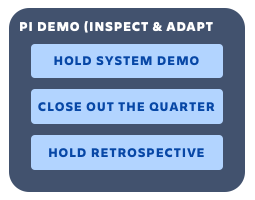Introduction

“Kaizen is about changing the way things are. If you assume that things are all right the way they are, you can’t do kaizen. So change something!” - Taiichi Ohno (Father of Toyota Production System)
Agility is not about moving fast, it’s about learning fast. Reviewing the work done, discussing the wins and obstacles faced, and determining how to change going forward is at the heart of any organization that truly embraces the concepts of agile.
Decisions to make
- Decide if the demoed work matches the vision/expectations of the internal/external stakeholders
- Based on the demo feedback, are we still building the right thing (e.g. should we pivot)?
- What work did we complete during the program increment? What work didn’t we complete during the program increment and have we communicated it?
- Decide what the biggest obstacles to program success are, and what changes are needed to overcome these obstacles in the future
- How are we going to uncover the root cause of the obstacles we experienced to ensure we are solving the right problems (e.g. 5-Whys)?
Context
- The program has a formal ceremony to bring together internal/external stakeholders to review progress on the functionality and see it working
- Improvement opportunities for the functionality and the team are captured
Why we care
- As the manifesto for agile software development states, “working software is the primary measure of progress,” meaning demoing working software beats a status report every time
- Work that doesn’t complete within a planning period needs to be reprioritized against the backlog, not simply added to the next planning period or shelved entirely
- Introspection is critical to improvement, meaning we need to examine our ability to deliver and how we felt throughout the process, then determine how we want to work differently in the future
- The focus is on continuously improving, meaning even if you do one small thing different you are better off going forward than you were before
- It’s one thing to inspect, but it’s even more import to adapt, meaning that we have to take action on the improvement items we identify (otherwise it’s just group therapy)
- Improvement items should be treated as first-class citizens in our backlog, meaning they hold equal priority to delivery work items, otherwise we send the message that improvement is not important
The Atlassian view
- Leveraging the program board, determine which features are complete at the end of each iteration/sprint and demo the functionality to internal/external stakeholders
- Capture delivered value within Jira Align objectives in order to report out on the impact of delivered work
- Leverage key results to quantifiably measure progress towards objectives based on delivered work
- Using key reports such as the program increment progress report, control chart, program predictability report, and velocity report will provide the program with data points to inspect and adapt on
- Leverage the Jira Align retrospectives functionality for program team retrospectives and the ideation functionality to allow all members of the program to retrospect together
- Using activities from the Atlassian Team Playbook can help elicit new improvement ideas from the program
Next step:
Jobs to be doneWas this content helpful?
Connect, share, or get additional help
Atlassian Community